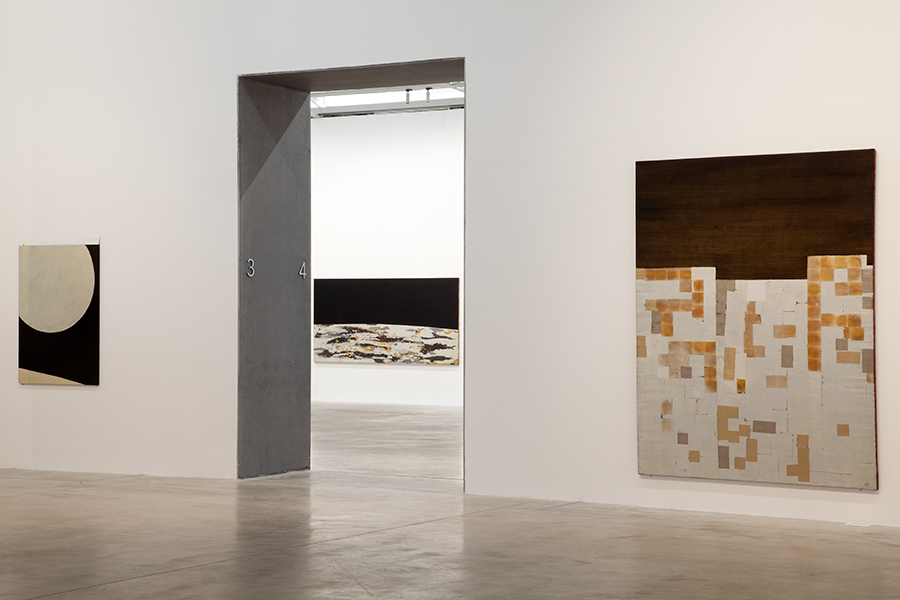Ice and Earth: The Shimmering Abstractions of Anna-Eva Bergman
At Bombas Gens, Valencia, a retrospective of the terrestrial geographies of the overlooked painter
At Bombas Gens, Valencia, a retrospective of the terrestrial geographies of the overlooked painter

Born in Sweden in 1909 and raised in Norway, Anna-Eva Bergman exhibited regularly in Paris during the 1960s and 1970s, including a 1977 retrospective at Musée d’Art moderne de la Ville de Paris. Yet since her death in 1987, her sparkling art has received scant attention. At Bombas Gens, ‘From North to South, Rhythms’ gathered more than eighty paintings and works on paper realised between 1962 and 1971, the majority loaned by the Fondation Hartung Bergman in Antibes (Bergman was twice married to the German-French painter Hans Hartung).
During this period in Paris, Bergman fortified her art’s most salient motifs – slabs of rock and ice, earthy expanses, and veils of sea-and-sky – by drawing on experiences of Spain, especially during her almost yearly visits to the volcanic landscapes of Cabo de Gata in Andalucía and an exploration, camera in hand, of the remote Barents Sea coast in the north-easternmost Norwegian county of Finnmark. Through these apparently incompatible geographies, Bergman arrived at a place in painting that was too ineffable to be described as landscape, yet not wholly abstract. She layered canvases with metal foils and modelling medium, deposited them with acrylic, or frosted over them with tempera and pastel. Pictorial form was often made simply through a bisecting line’s allusion to the horizon.

In Nº 48-1971 Mur de glace (Ice Wall) (1971), a fissure of deep ultramarine is placed abruptly above a glacial field of shimmering silver leaf. The vertical format Nº 67-1966 Grand océan (Big Ocean) (1966), hanging in Valencia on an adjacent wall, sees a radiant gradient formed from laminates of brushwork and metal foils that gloriously transitions from an inky oceanic depth to a glinting of distant waves. Bergman’s fascination with spare and unwitnessed natural beauty, and the loss of spatial orientation through icy immensity or arid deserts, urged a state of mystical consciousness in her work. Nº 2-1966 Finnmark Hiver (Winter Finnmark) (1967), imagines a field of view filled with a bituminous sky above an extent of shattered ice that has an almost imperceptible camber, as if we’re high enough above the planet to observe its curvature.
Smaller works are no less intense and seemed to reach back to premodern devotional panels and Byzantine religious icons. L’or de vivre – Rocher (The Richness of Living – Crag) (1965), for example, conjures an atmospheric illusion of the first seconds of a desert day, as golden light emanates from behind a hulking outcrop of rock. It suits direct one-on-one contemplation, and movements of your head, in contrast to the startling widescreen scale of other works, such as the three metre-wide Nº 12-1967 Grans Finnmark rouge (Big Red Finnmark) (1967). This canvas invites immersion in the changing effects of opalescence and evanescence as you walk past it. Both the intimacy and vastness thrive in the two luminous galleries afforded to the show at Bombas Gens.

The accompanying catalogue includes a detailed chronology of the artist’s life and career, as well as a selection of the hundreds of photographs she took in Spain and Norway. This brings a personal and geographical specificity to Bergman’s abstraction; likewise, the texts largely avoid the temptation of pointing out formal resemblances or discrepancies with the work of better-known painter peers, almost inevitably male. In her essay ‘We are stone’ (2018), artist Teresa Lanceta argues that Bergman’s peers are not necessarily painters at all, but fellow women artists such as Tacita Dean, Eva Hesse or Ana Mendieta. Bergman, she argues, strived for understanding rather than mastery, exchange rather than rebellion. In Nº 55-1969 Autre terre, autre lune (Another Land, Another Moon) (1969) a shining celestial sphere looms large in the top half of the canvas. Here Bergman appears to have strived for something beyond home-planetary art entirely, as we head out towards cosmic geology and astral abstractions.
Anna-Eva Bergman, 'From North to South, Rhythms' was on view at Bombas Gens, Valencia, from 14 November 2018 until 5 May 2019 and will tour to the Palacio de Velázquez, Museo Nacional Centro Reina Sofía, Madrid, in May 2020.
Main image: Anna-Eva Bergman, N° 12-1967 Grand Finnmark rouge (Big Red Finnmark) [detail], 1967, vinyl and metal sheet on canvas, 1.5 × 3 m. Courtesy: Fondation Hartung-Bergman, Antibes © Anna-Eva Bergman / ADAGP, Paris, 2018






















